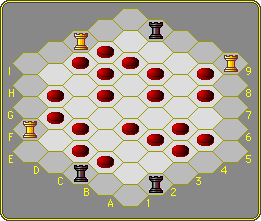Object
There are 19 beads in the game. The first player to capture 10 of them wins.
 | The initial position: the 'Marquisian Method'
The Marquisian Method to balance a game is named after a 19th century French Draughts player who made money by offering opponents a similar choice in a particularly nasty endgame of which he knew every nook and cranny, and betting on the outcome. The main characteristic of the method is that it allows the player who makes the initial position, to present an in-deep studied piece of homework. It is therefore not a true balancing method, yet it takes that form in games between less experienced players. In the case of more experienced players, the fun for Player Two is to figure out the nasty tricks his opponent has woven into the position, and try to let him fall into his own traps. |
The initial set-up is totally up to Player One. He puts three white and three black rooks on the edge of the board and 19 'beads' on cells of the inner area.
Player Two then may choose to either to:
- move first, in which case his opponent decides on color, or
- choose a color, in which case his opponent moves first.
| Swish This being settled, players move, and must move, in turn. Each player must, on his turn, move one of his rooks. A rook must always end its move on a vacant cell. It may move:
Play Swish interactively |
Squeeze This being settled, players move, and must move, in turn. Each player must, on his turn, move one of his rooks. A rook must always end its move on a vacant cell.
Play Squeeze interactively |
How I invented ... Swish & Squeeze
External links
Swish & Squeeze © MindSports
